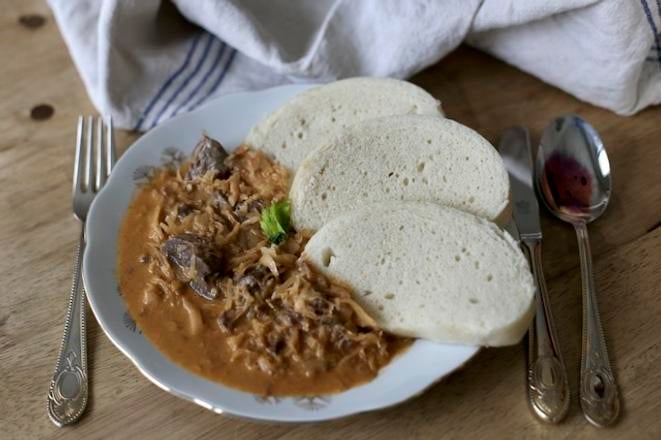Segedínsky guláš is a stew made with meat - usually pork - sauerkraut, and cream. Cooking the sauerkraut and adding cream both temper the acidity of the saurkraut. In areas of Slovakia where wheat is more abundant, the stew is served with knedle, steamed bread that soaks up the broth. In areas where potatoes are easier to grow, potatoes are put in with the stew and mashed with a fork.
The origin of the name segedínsky guláš in Slovak is disputed. Literally, it means goulash from the town of Szeged. There is a town in Hungary called Szeged, and there is even a goulash from Szeged, but it is a completely different stew of vegetables.
Some speculate that Szeged could refer to where the paprika was grown, but others speculate the name is a corruption of Székely goulash, Székely being a personal last name. It could be a writer, a painter, or, more often, a librarian. The librarian and a famous poet went out to eat at an inn, and either the cook had already left or ingredients were getting low, and the innkeeper put together what he had - gulash, sauerkraut, and cream. Székely enjoyed it so much that later the poet ordered it again, calling it Székely's cabbage.
Whatever the name origins, Slovak creamy sauerkraut stew is surprisingly easy to make. While the meat does need time to soften, you don't need to chop up a bunch of vegetables - the cabbage is already shredded. Sauerkraut is a traditional staple in Slovakia, the fermenting process preserving the harvest all winter long. We shared how to make sauerkraut here.
Pork is usually used to make segedínsky guláš, using a tough cut for stews means that once the meat cooks it will be soft and moist. I've also made it with beef and, in these pictures, with venison. The goulash is pictured with knedle, soft steamed bread, but feel free to use potatoes if knedle aren't readily available where you live.
INGREDIENTS
2 large onions
50 ml/3 heaping tablespoons lard or other fat
600grams/1.3 lb stew meat (pork or other)
1 teaspoon caraway
1 bay leaf
1 kilo/2.2 lbs sauerkraut
1.25 litre/4.5 cups water
30 ml/2 tablespoons paprika
230 ml/1 cup heavy cream
2 tablespoons flour (or cornstarch)
salt and pepper to taste
PROCEDURE
1. Chop onions. Melt lard or other oil in large pot, cook onions over slow heat until softened, stirring occasionally.
2. Chop meat into cubes and add to onion, as well as caraway and bay leaf. Turn the heat up to brown the meat.
3. Add paprika, stir, and quickly pour 2 cups of water in (paprika burns quickly). There should be enough water so that the meat still sticks out from the level of teh water. Cover with a lid and let simmer, 1 hour for pork, 3 hours for beef.
4. Coarsely chop sauerkraut so you don't have long strings of cabbage and add to the simmering pot. Add more water, about 2 cups so that the contents of the pot looks like a thick stew. Simmer until the sauerkraut is soft, about 20 min.
5. Add cream. Mix flour or cornstarch with 1/2 cup of water or milk, stir vigorously, and pour into stew, stirring the stew the whole time. Simmer until the broth thickens, about 15 minutes for the flour taste to reduce, or a couple of minutes for cornstarch.
6. Serve on a plate or shallow bowl with knedle or boiled potatoes.


